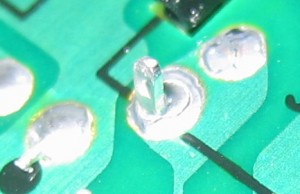A while back I posted about having ordered EyeTV and the HD Homerun. I promised a post once it all arrived and here it is.
If you didn’t visit any of the links I provided before then here is a quick over view of what I ordered. The HD Homerun is a network based dual ATSC/QAM tuner. ATSC is the new digital broadcast standard and QAM is the how many channels are distributed on the cable system. Chances are the cable TV provider in your area provides at least some QAM channels. The HD Homerun has two hook ups meaning I can record two shows at once or watch and record a show or even watch two shows at the same time. The HD Homerun will also allow you to use one of the ports for ATSC and the other for QAM if you so choose. The HD Homerun’s ethernet port runs at 100Mbit and easily supports watching a pair of channels. Based on some entirely unscientific google searching, I found that the highest bitrate available using ATSC is about 19Mb/s while QAM is around 56Mb/s. Like a wireless network, neither actually hit those rates often so the HD Homerun is quite capable of streaming two channels at the same time.
I went with the HD Homerun over any of the other tuner options because it doesn’t lock me into a tuner that works only on the Mac platform. As much as I love Mac and all I just didn’t want to drop cash on a solution that would tie me indefinitely to the Mac platform for watching and recording TV.
EyeTV is software for the Mac that can talk to the HD Homerun to watch a show or record (or both). It provides a some what confusing interface that lacks any sort of intuitive flow. This is really unlike most Mac apps. For example, when using the program guide you can click on a show to view details about the show such as a full description. Once on this screen, there is no clear indication of how to return to the program guide again. There is no back button of any sort and clicking on the Program guide button again doesn’t bring you back where you were. Instead, you are supposed just click anywhere on the detail screen to go back where you were.
Despite the interface EyeTV works rather well. One of my favorite things about EyeTV is how it works with the Mac to wake it when it is time to do a recording and the EyeTV helper app will launch EyeTV. While I have heard rumors of Windows Media Center being able to do this I’m not entirely sure that it can and can do it reliably.
Another thing EyeTV can do is re-encode and then share via HTTP any recordings that have via the network. The encoding is small enough to work with a 802.11g network yet of good quality. Best of all you’re not tied to just viewing the files on another Mac, Windows is welcome too.
If you looking for a way to watch and/or record TV the HD Homerun plus any DVR software package is a good bet. EyeTV for the Mac is definitely the way to go despite some interface shortcomings if you are a Mac user. If you like MythTV on Linux or Media Portal or Media Center on Windows the HD Homerun is a great choice.
